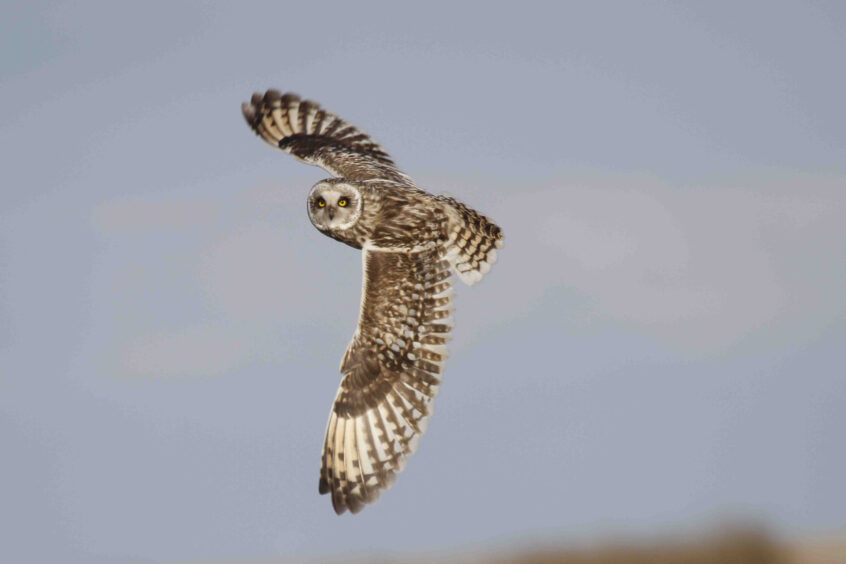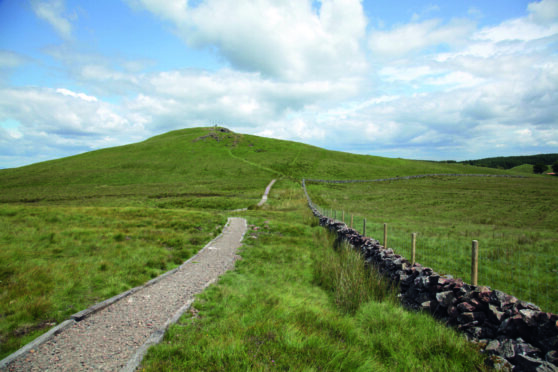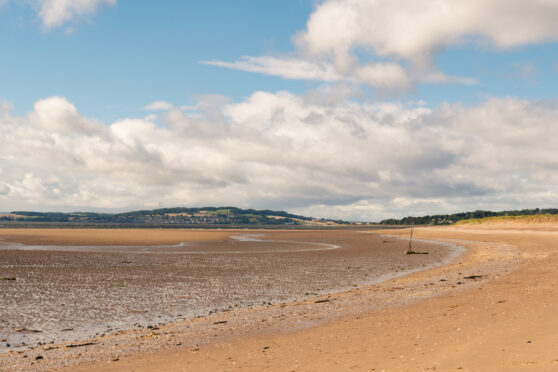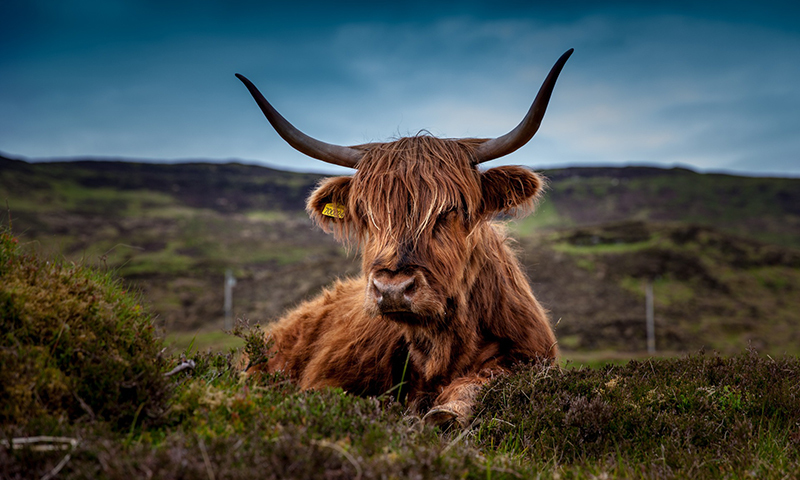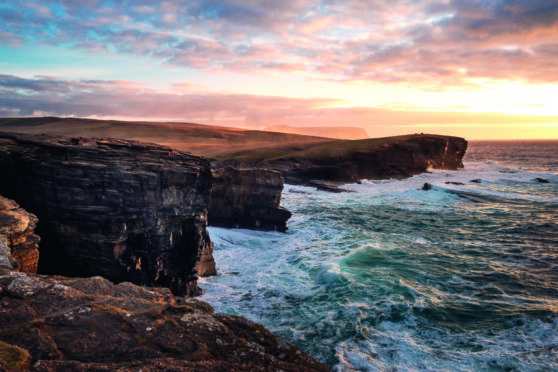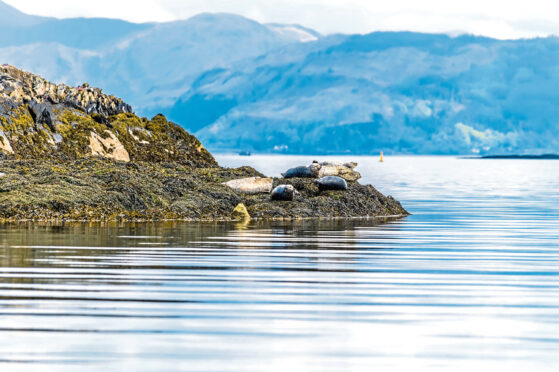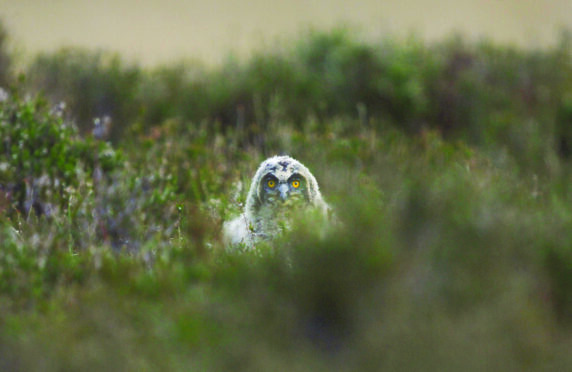
I see you, long-eared owl, standing erect on an autumn oak tree’s out-flung limb, you with your autumn oak tree plumage, your light browns and dark browns and orangey browns, pretending to be a piece of an oak tree, pretending to have long ears, pretending to not be there.
You don’t fool me.
That’s not true, of course. You’ve fooled me all the time I’ve been sitting beside this burn with the open hill behind me and on the far side from your woodland edge.
Some of the time I’ve been watching the trees and the sky and the water, and some of the time I was looking down at the notebook in my lap because that’s how I like to go to work best. But all of that time, until right now, I had no idea you were there, pretending to be an October oak.
You must have seen me arrive and not flinched. You saw me unpack a couple of things from my backpack – the usual nature writer survival kit of a mat to sit on, a flask, a banana and a Bounty bar, the notebook of course and a pen.
You trusted to being a tree all this time, which is more than an hour now.
What changed? A flypast of late, south-making swallows glittered above the wood in early evening sunlight and I followed them for perhaps 10 seconds in the binoculars, wished them a safe journey as they vanished, dragged the glasses back along the canopy of the trees and suddenly there you were. Even then, I only found you because you did that owl trick with your head where suddenly the back of your head is where your eyes were a moment ago, and then your eyes reappeared and your fake ears stood on end.
Then you did that leaning forward while moving your head from side to side thing that owls do as if they were trying to get a better look, or to look scarier, or…or something else I haven’t thought of yet. But then you were still and pretending to be a tree again, and this is what I saw:
The ears-that-aren’t-ears were raised and dark brown and leaf-shaped and facing forward – the actual ears are on the side of the head like most birds. Since you did that side-to-side thing and resumed your upright pose, you stretched yourself to look taller and thinner and scarier and your face changed shape to tall and thin too, a disconcerting thing to watch in binoculars even for a six-foot human.
The eyes sit either side of a narrowing white vee, and a white moustache decorates either side of the beak. From head to toe, the entire perched bird wears the streaks and patches of oak bark in autumn, which is why it spends so much time pretending not to be there at all, a trick at which it excels. Its colours are always autumn woodland, so maybe spring would be a better time.
My hunch is that this is a bird on the move, a north-to-south migrant that prefers night flying to day flying. The trouble is that some Scottish long-eared owls migrate and some don’t.
I’m guessing it’s a migrant because I sit here often and I have never seen one here before, but then again that could be because it always fool me into thinking it’s a bit of a tree.
After a couple of hours I was ready to move but didn’t want to disturb the owl which now seemed to have forgotten about me. Then quite suddenly it flew and transformed itself from a piece of a tree into a recognisable side-on portrayal of a flying owl.
It flew up the burn then vanished round the end of the wood, going north, which is not the way to migrate in October, so perhaps it just fooled me again.
The short-eared owl is a bird of a different feather. I know where to look for it because it doesn’t hide in trees and doesn’t shun the daylight, and hunts the wide open rough ground of high moors and the east coast marshes and sand dunes.
The moor-nesters migrate to the coast, the coast-nesters might migrate far south, and some European nesters migrate across the North Sea to winter on the east coast too, and that’s when it can get really confusing, because it’s not unknown for short-eared and long-eared owls to cross the North Sea at the same time, and sometimes together, which suggests a critical shortage of food in their mainland Europe homelands, usually Scandinavia.
Some landfalls have made headlines. The one I would love to have seen was the arrival of 50 long-eared owls on the Isle of May in October 1989. Can you imagine what that looked like, not just the landfall but the flight down the northern ocean, a compact mass or a scattered straggle, visible from ships and oil rigs, or seen in offshore flight from a cliff top? And hundreds of feet high or at wave top height?
The illimitable variations of bird migration are as bewildering as they are enchanting, and while owls might not be the first creatures to spring into mind when October dawns, it’s a good time to wander the east coast with one eye on the sea and the other on the inland dunes and marshes.
And if you are lucky enough to see them make landfall, it’s worth knowing that eastern Scotland might just be a stop-off on a much longer-haul affair.
Owls from Scandinavia that arrived here are known to have moved on to the Netherlands and Belgium – they crossed the North Sea twice in a single journey. And bear in mind that this is no reliable ritual like the passage of geese or swans from say Greenland or Iceland, this is a haphazard, wandering voyage that implies a sophisticated knowledge of hundreds if not thousands of miles of coastline on both sides of the North Sea.
I see you, short-eared owl, standing aslant on a high moorland tussock. You with your plumage the shades of winter grasses and withered heather, just like a piece of an October moor, yet you don’t pretend to be one.
You’re more my kind of owl than your kinsman skulking in oak trees. I’ve been watching you quarter the moor for half an hour, during which time you made four attempts to reduce the vole population and, as far as I could make out, you might have been successful just once.
My uncertainty is because the one time when you spent quite a while on the ground, long enough to despatch a vole, you had your back to me and you were surrounded by withered heather.
But now look at you! Not only do you not skulk in trees, nor pretend to be a piece of moor, you just flew directly towards me and clamped on to a roadside fencepost about 50 yards away.
Then you turned to stare. Those eyes of orangey gold! When the 18th-Century Swedish botanist and zoologist Carl Linnaeus had the brainwave of using Latin as an international language for identifying species, the system – still in use to this day – had possibly its finest hour with the short-eared owl: Asio flammeus which means flaming eyes.
I still think flame-eyed owl would be a substantial improvement on short-eared owl given that we have known for years that the “ears” are feathered tufts serving no known purpose. And the long-eared owl could become the skulking owl.
At no time since I turned up on the moorland road was the short-eared owl unaware of my presence. There was nowhere to hide so I leaned on a fencepost and trusted to stillness.
I was intrigued that eventually the owl decided to inspect me at close quarters, a long, flame-eyed stare just a handful of fenceposts away. The notion of being inspected was supported by the owl’s next move, which was to fly across the road and begin at once to hunt on the far side.
Otherwise, why stop to stand and stare? That’s the strange thing about getting to know owls. They leave you with more questions than answers.
Into the wild: jimcrumleynature.com

Enjoy the convenience of having The Sunday Post delivered as a digital ePaper straight to your smartphone, tablet or computer.
Subscribe for only £5.49 a month and enjoy all the benefits of the printed paper as a digital replica.
Subscribe